
Stanley Grauman Weinbaum was an American science fiction writer. His first story, "A Martian Odyssey", was published to great acclaim in July 1934; the alien Tweel was arguably the first character to satisfy John W. Campbell's challenge: "Write me a creature who thinks as well as a man, or better than a man, but not like a man." Weinbaum wrote more short stories and a few novels, but died from lung cancer less than a year and a half later.
"Robbie" is a science fiction short story by American writer Isaac Asimov. It was the first of Asimov's positronic robot stories. In 2016, "'Robbie" won a retrospective 1941 Hugo Award for best short story. "Robbie" was the fourteenth story written by Asimov, and the ninth to be published. It was the first story in Asimov's Robot series.

The Early Asimov or, Eleven Years of Trying is a 1972 collection of short stories by Isaac Asimov. Each story is accompanied by commentary by the author, who gives details about his life and his literary achievements in the period in which he wrote the story, effectively amounting to a sort of autobiography for the years 1938 to 1949.
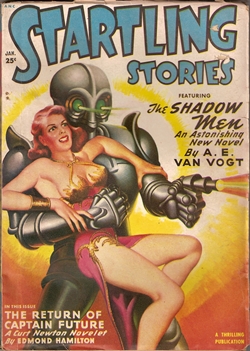
Startling Stories was an American pulp science fiction magazine, published from 1939 to 1955 by publisher Ned Pines' Standard Magazines. It was initially edited by Mort Weisinger, who was also the editor of Thrilling Wonder Stories, Standard's other science fiction title. Startling ran a lead novel in every issue; the first was The Black Flame by Stanley G. Weinbaum. When Standard Magazines acquired Thrilling Wonder in 1936, it also gained the rights to stories published in that magazine's predecessor, Wonder Stories, and selections from this early material were reprinted in Startling as "Hall of Fame" stories. Under Weisinger the magazine focused on younger readers and, when Weisinger was replaced by Oscar J. Friend in 1941, the magazine became even more juvenile in focus, with clichéd cover art and letters answered by a "Sergeant Saturn". Friend was replaced by Sam Merwin Jr. in 1945, and Merwin was able to improve the quality of the fiction substantially, publishing Arthur C. Clarke's Against the Fall of Night, and several other well-received stories.

Wonder Stories was an early American science fiction magazine which was published under several titles from 1929 to 1955. It was founded by Hugo Gernsback in 1929 after he had lost control of his first science fiction magazine, Amazing Stories, when his media company Experimenter Publishing went bankrupt. Within a few months of the bankruptcy, Gernsback launched three new magazines: Air Wonder Stories, Science Wonder Stories, and Science Wonder Quarterly.

Neil Ronald Jones was an American writer who worked for the state of New York. His first story, "The Death's Head Meteor", was published in Air Wonder Stories in 1930, possibly recording the first use of "astronaut" in fiction. He also pioneered cyborg and robotic characters, and is credited with inspiring the modern idea of cryonics. Most of his stories fit into a "future history" like that of Robert A. Heinlein or Cordwainer Smith, well before either of them used this convention in their fiction.
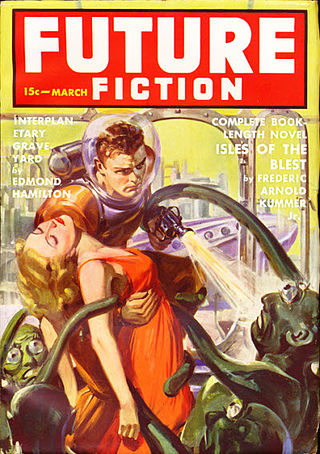
"Ring Around the Sun" is a science fiction short story by American writer Isaac Asimov. It was first published in the March 1940 issue of Future Fiction and reprinted in the 1972 collection The Early Asimov. "Ring Around the Sun" was the fifth story Asimov wrote, and also the fifth to be published.

"A Martian Odyssey" is a science fiction short story by American writer Stanley G. Weinbaum originally published in the July 1934 issue of Wonder Stories. It was Weinbaum's second published story, and remains his best known. It was followed four months later by a sequel, "Valley of Dreams". These are the only stories by Weinbaum set on Mars.
"The Imaginary" is a science fiction short story by American writer Isaac Asimov. It first appeared in the November 1942 issue of Super Science Stories and was reprinted in the 1972 collection The Early Asimov. Following the sale of "Half-Breeds on Venus", which was a sequel to "Half-Breed", Asimov suggested to Astounding Science Fiction editor John W. Campbell that he write a sequel to the story "Homo Sol". Campbell was unenthusiastic, but agreed. Since "The Imaginary" lacked the human-alien conflict that he had liked in the earlier story, Campbell ultimately rejected it. "The Imaginary" was the twenty-first story written by Asimov, and the twenty-ninth to be published. Due to the peculiar workings of the science fiction magazine publishing industry, "The Imaginary" appeared a month after the third story in the Homo Sol Trilogy, "The Hazing".

"Heredity" is a science fiction short story by the American writer Isaac Asimov. Asimov wrote the story, his twenty-third, in August 1940 under the title "Twins". It was rejected by John W. Campbell, editor of Astounding Science Fiction, on 29 August, and accepted by Frederik Pohl on 4 September. It appeared in the April 1941 issue of Astonishing Stories under the title "Heredity" and was reprinted in the 1972 collection The Early Asimov. Heredity was the second Asimov story to receive a cover illustration.
"The Portable Star" is a science fiction short story by American writer Isaac Asimov, which appeared in the Winter 1955 issue of Thrilling Wonder Stories. "The Portable Star" was Asimov's least favorite story.
"Christmas on Ganymede" is a science fiction short story by American writer Isaac Asimov. It was written in December 1940, first published in the January 1942 issue of Startling Stories, and reprinted in the 1972 collection The Early Asimov and the anthology Christmas on Ganymede and Other Stories, edited by Martin H. Greenberg. It was the twenty-sixth story written by Asimov, and the nineteenth to be published.
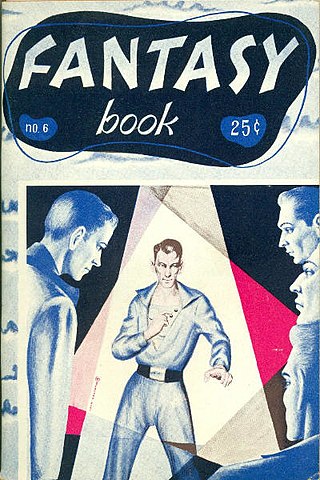
"The Little Man on the Subway" is a fantasy short story by Isaac Asimov and Frederik Pohl, originally published in the 1950 issue of Fantasy Book, and included in the 1972 collection The Early Asimov. It was initially written in 1941 by Asimov's friend, the author/agent/writer Frederik Pohl, under the pen name of James MacCreigh. Unable to get it right, Pohl asked Asimov to rewrite it, which he did. It was rejected by John W. Campbell and Asimov forgot about it. The story was finally sold to Fantasy Book in 1950.
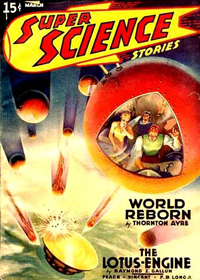
Super Science Stories was an American pulp science fiction magazine published by Popular Publications from 1940 to 1943, and again from 1949 to 1951. Popular launched it under their Fictioneers imprint, which they used for magazines, paying writers less than one cent per word. Frederik Pohl was hired in late 1939, at 19 years old, to edit the magazine; he also edited Astonishing Stories, a companion science fiction publication. Pohl left in mid-1941 and Super Science Stories was given to Alden H. Norton to edit; a few months later Norton rehired Pohl as an assistant. Popular gave Pohl a very low budget, so most manuscripts submitted to Super Science Stories had already been rejected by the higher-paying magazines. This made it difficult to acquire good fiction, but Pohl was able to acquire stories for the early issues from the Futurians, a group of young science fiction fans and aspiring writers.
A stowaway is someone who travels illegally on a vehicle.

Harl Vincent was the pen name of Harold Vincent Schoepflin, an American mechanical engineer and science fiction author. He was published regularly in science fiction pulp magazines.
Astonishing Stories was an American pulp science fiction magazine, published by Popular Publications between 1940 and 1943. It was founded under Popular's "Fictioneers" imprint, which paid lower rates than Popular's other magazines. The magazine's first editor was Frederik Pohl, who also edited a companion publication, Super Science Stories. After nine issues Pohl was replaced by Alden H. Norton, who subsequently rehired Pohl as an assistant. The budget for Astonishing was very low, which made it difficult to acquire good fiction, but through his membership in the Futurians, a group of young science fiction fans and aspiring writers, Pohl was able to find material to fill the early issues. The magazine was successful, and Pohl was able to increase his pay rates slightly within a year. He managed to obtain stories by writers who subsequently became very well known, such as Isaac Asimov and Robert Heinlein. After Pohl entered the army in early 1943, wartime paper shortages led Popular to cease publication of Astonishing. The final issue was dated April of that year.
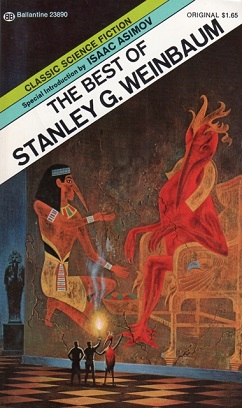
The Best of Stanley G. Weinbaum is a collection of science fiction stories by Stanley G. Weinbaum, published in 1974 as an original paperback by Ballantine Books as a volume in its Classic Library of Science Fiction. The volume included an introduction by Isaac Asimov and an afterword by Robert Bloch. Ballantine reissued the collection twice in the later 1970s; Garland Publishing published a library hardcover edition in 1983, and Sphere Books released a UK market edition in 1977, under the title A Martian Odyssey and Other Stories. The original edition placed third in the 1975 Locus Poll for best genre collection.

Science-fiction and fantasy magazines began to be published in the United States in the 1920s. Stories with science-fiction themes had been appearing for decades in pulp magazines such as Argosy, but there were no magazines that specialized in a single genre until 1915, when Street & Smith, one of the major pulp publishers, brought out Detective Story Magazine. The first magazine to focus solely on fantasy and horror was Weird Tales, which was launched in 1923, and established itself as the leading weird fiction magazine over the next two decades; writers such as H.P. Lovecraft, Clark Ashton Smith and Robert E. Howard became regular contributors. In 1926 Weird Tales was joined by Amazing Stories, published by Hugo Gernsback; Amazing printed only science fiction, and no fantasy. Gernsback included a letter column in Amazing Stories, and this led to the creation of organized science-fiction fandom, as fans contacted each other using the addresses published with the letters. Gernsback wanted the fiction he printed to be scientifically accurate, and educational, as well as entertaining, but found it difficult to obtain stories that met his goals; he printed "The Moon Pool" by Abraham Merritt in 1927, despite it being completely unscientific. Gernsback lost control of Amazing Stories in 1929, but quickly started several new magazines. Wonder Stories, one of Gernsback's titles, was edited by David Lasser, who worked to improve the quality of the fiction he received. Another early competitor was Astounding Stories of Super-Science, which appeared in 1930, edited by Harry Bates, but Bates printed only the most basic adventure stories with minimal scientific content, and little of the material from his era is now remembered.

Robert Silverberg Presents the Great SF Stories: 1964 is an American anthology of short stories, edited by Robert Silverberg and Martin H. Greenberg, first published in hardcover by NESFA Press in December 2001. It is a continuation of the Isaac Asimov Presents The Great SF Stories series of short story anthologies, which attempts to list the great science fiction stories from the Golden Age of Science Fiction. This book is a continuation of the book series The Great SF Stories originally edited by Isaac Asimov and Martin H. Greenberg with the last one published in 1992.














